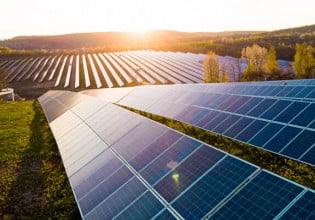NIST Measurement Advance Could Speed Innovation in Solar Devices
A new versatile measurement system devised by researchers at the National Institute of Standards and Technology (NIST) accurately and quickly measures the electric power output of solar energy devices, capabilities useful to researchers and manufacturers working to develop and make next-generation solar energy cells.
Innovative devices that convert sunlight to electric power more efficiently and cost effectively than the current generation of solar cell technology are the objects of a global pursuit – means to reducing fossil-fuel consumption and to securing pole position in the competition for fast-growing international markets for clean energy sources.
The NIST team has combined 32 LEDs – each generating light from different segments of the solar spectrum – and other off-the-shelf equipment with their custom-made technologies to build a system that measures the wavelength-dependent quantum efficiency of solar devices over a relatively large area.
Anticipated advantages over current approaches – most of which use incandescent lamps or xenon arc and other types of discharge lamps – are greater speed and ease of operation, more uniform illumination, and a service life that is about 10 times longer.
The new NIST system for measuring spectral response easily accommodates two unique but complementary methods for determining how much electric current a solar, or photovoltaic (PV), device generates when hit by a standard amount of sunlight. Both methods are straightforward, and they use the same hardware setup.
With either method, the automated system produces measurements more rapidly than current instruments used to simulate solar radiation and characterize how efficiently a device converts light energy to electric energy.
One method, which activates the LED lights sequentially, is less subject to interference than the other technique, and yields a spectral response measurement in about 6 minutes. With the other method, all 32 LEDs are activated simultaneously, but each generates pulses of light at a different rate. The solar response of a PV device over the entire LED-blended spectrum can be determined in about 4 seconds.
Though more susceptible to interference, the faster method has potential for in-line manufacturing tests for ensuring quality, the researchers write. The new system represents a major stride toward a technical goal set by a group of solar energy experts convened by NIST in late 2010.
"To accelerate all types of PV development and lower costs through more accurate assessment of performance," these experts set the goal to achieve spectral response measurements in fewer than 10 minutes.
While the new system beats the time requirement, the NIST team must push their technology further to match related targets that are part of the goal. Their to-do list includes matching or exceeding the energy intensity of the sun, broadening the LED-synthesized spectrum to include the infrared portion of the sun’s output, and consistently achieving measurement results with uncertainties of less than 1%.
With their work to date, however, the NIST researchers have demonstrated that LEDs are now "technologically viable" for use in solar simulators and for characterizing PV and other photoelectric devices, says NIST physicist Behrang Hamadani.
More news and information regarding the latest developments in Smart Grid electronics can be found at Darnell’s SmartGridElectronics.Net.






